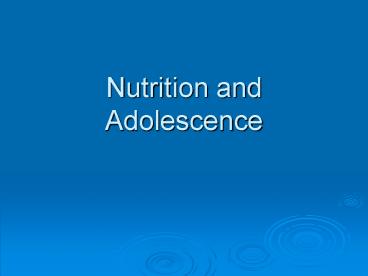Nutrition and Adolescence - PowerPoint PPT Presentation
1 / 26
Title:
Nutrition and Adolescence
Description:
Body temperature differences, etc. Treatment for Obesity ... Over concern with body shape and weight. Problems with Bulimia. Dental decay. Throat irritation ... – PowerPoint PPT presentation
Number of Views:275
Avg rating:3.0/5.0
Title: Nutrition and Adolescence
1
Nutrition and Adolescence
2
Adolescence Growth
- Increased Rate of Growth need for more Kcal and
Nutrients - Thru 8 yo No DRI/RDA difference between sexes
- At 9, sex specific DRI/RDAs are made
- Based on difference in growth spurt
3
Peak Growth Velocities
- Sex Ht Wt
- Male 10.3 cm/y 9.8 kg/yr
- 14.1 yrs 14.3 yrs
- Female 9.0 cm/yr 8.8 kg/yr
- 12.1 yrs 12.9 yrs
4
Peak growth velocities generally happen ______ in
males than females.
- 2 years earlier
- 2 years later
- About the same time
- 4 years earlier
- None of the above
5
Adolescence Requirements
- Age or Weight alone are not good predictors of
energy/nutrient needs - Rate of growth is most important factor
- Difficult to measure at any given time
6
Energy and Protein
- Energy
- female 11-14yo 1500-3000 kcal/day
- male 15-18 2100-3900 kcal/day
- Protein
- 12-16 of total energy needed
7
Energy in Adolescents
- Age Allowance Ref. Ht Energy
- (cm)
kcal/cm - Males
- 11-14 2500 157 15.9
- 15-18 3000 176 17.0
- Females
- 11-14 2200 157 14.0
- 15-18 2200 163 13.5
8
Mineral Needs
- Calcium Needs depend on rate of growth
- 1300 mg/day is Adequate Intake (AI) for males
females 9-18 years - Good sources of calcium are very important for
proper bone development - Concern about switch from milk to soda pop
- Iron Needs related to growth
- Also to menstruation in females
- RDA 11 mg/day for males and 15/mg/day in females
14-18 years
9
Adolescence and Body Image
- Females Think they are overweight
- Males Think they are too skinny
- What influences these thoughts?
- Family
- Peers
- Media
- Independence food selection
10
Eating Disorders
- Obesity Approx. 10 to 20 of adolescents are
obese and will remain obese as adults. This is
escalating as we speak! - Psychologic factors Developmental obesity
- Food abuse as a result of abnormal family
interactions - Physiologic factors Examples
- Set-point theory
- Lower basal energy need
- Body temperature differences, etc
11
Treatment for Obesity
- Make sure the adolescent has reached full height
- Make sure the adolescent is committed
- Consider failure and self-esteem of adolescent
- If the Adolescent is a good candidate, slow
weight loss with increased activity and diet
modification are used.
12
Eating Disorders Anorexia Nervosa
- Up to 5 of females 12-18 yrs display disordered
eating - 9 die of starvation
- 2-5 commit suicide
- 20 have decreased bone density
- Other problems
- decreased heart size
- damage to sex organs
- abnormal metabolic rate
13
Anorexia Diagnosis Dx defined by Am. Psychiatric
Assoc.
- Refusal to maintain body wt. 15 below expected
- Fear of gaining wt even though under wt
- Disturbance in body image
- Absence of three consecutive menstrual cycles
14
All but one of the following are APA criteria for
diagnosis of Anorexia.
- Refusal to maintain body weight
- Fear of gaining weight
- Absence of 1 menstrual cycle
- Disturbed body image
- All of the above are criteria for Anorexia
15
Bulimia Nervosa
- Incidence 2-4 of college females may meet
criteria with as many as 20 showing some
characteristics - Symptoms gorging with vomiting or purging
(vomiting, laxative, excessive exercise)
16
APA Criteria for Bulimia
- Recurrent episodes of food binging
- lack of control over binges
- regular self-induced vomiting, use of laxatives,
diuretics, strict dieting or fasting or vigorous
exercise - average of 2 or more binges/week for 3 months
- Over concern with body shape and weight
17
Problems with Bulimia
- Dental decay
- Throat irritation
- Esophageal inflammation
- Rectal Bleeding
- Swollen Salivary glands
- broken blood vessels in face and throat
- Dehydration
- Fistulas
- Kidney damage
- Syrup of ipecac toxicity
18
Eating Disorder Treatment
- Psychotherapy Address the underlying problem
- Medical Keep the person alive while therapy
happens - Nutritional Meet clients nutritional needs
re-learn proper eating habits and intakes - Client has lost touch with what is normal
19
Effective eating disorder treatment requires
which of the following
- Psychotherapy
- Medical care
- Nutrition education/intervention
- 1 and 2
- All of the above
20
Adolescent Pregnancy
- Factors affecting pregnant nutritional needs
- Growth
- Nutrient stores
- Gynecologic age
- Preconception nutritional status
- Overweight and physical maturity earlier
ovulation
21
Gynecologic Age
- The number of years between the onset of menses
and conception - More sexually mature adolescents have no more
physically-based complications than do adult
women - Few adolescents within 2 years of menarche
ovulate regularly - Those who become pregnant will need special
attention to reduce risk of lbw and other
complications
22
Complications of Adolescent Pregnancy
- 1st and 3rd trimester bleeding
- anemia
- difficult labor and delivery
- cephalopelvic disproportion
- PIH
- Infections
- Maternal mortality is 2.5 X greater than older
women
23
Hazards to Infant
- Prematurity
- stillbirth
- LBW
- perinatal and infant deaths
- physical deformities
24
Pregnant Adolescent Weight Gain
- How much weight would a non-pregnant adolescent
gain? - Postmenarcheal Yr lb kg
- 1 8 3.45
- 2 5 2.0
- 3 2 0.90
- 4 and 5 1.32 0.60
25
Rate of Weight Gain
- Normal wt .361-.529(.440 avg)kg/wk
- Underweight .386-.588(.490 avg)kg/wk
- Overwt .218-.386(.300 avg)kg/wk
26
In the first year post-menarche, about how much
weight would you expect the non-pregnant person
to gain?
- Nothing
- 1 pound
- 8 pounds
- 30 pounds
- 40 pounds































